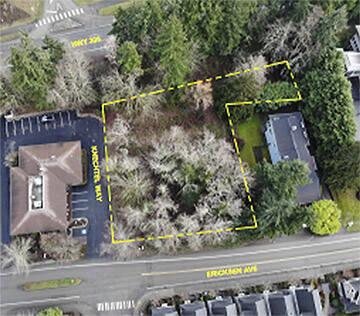An 18-unit, three-floor apartment building on 730 Ericksen Ave. that is 100 percent affordable housing was approved by Bainbridge Island’s Design Review Board recently.
The project now goes to the Planning Commission.
The main condition the DRB allowed was a buffer of less than the allowable 25 feet in a small area because of a rain garden being built there. DRB members felt the advantage of a rain garden was worth the tradeoff.
Charlie Wenzlau Architects is doing the project for Housing Resources Bainbridge on the site assessed at over $1.06 million in 2020. The units are one or three bedrooms.
Ellen Farleigh, an associate city planner, said it was the DRB’s final review and the last step in the pre-application phase. Because it’s an affordable housing project it was given incentives such as reduced parking, setbacks and increased height.
She was asked why the rain garden could not just be included in the buffer. City code says so, but she did not know the reasoning behind it. A board member suggested changing that at some point.
But board member Todd Thiel said he did not want to set a precedent of reducing a buffer for a rain garden. But it was worthy to do in this case.
Wenzlau said less than 5 percent of the required buffer is being carved out by the rain garden. “We’re not reducing, just carving it out,” he said, adding the buffer still averages 35 feet.
“I think it’s great, a creative idea. I think a lot of thought went into that,” DRB chair Bob Russell said.
Wenzlau said the reduction is really for the betterment of the environment because a rain garden is a much better way to get water to the trees.
Speaking of trees, Wenzlau said the project will have 90. To fulfill the city’s tree requirement he fears overplanting. “Cramming in all those trees is not going to be healthy,” he said.
Wenzlau said developers are doing everything they can to fulfill the intent of the code, but because it is so tight they had to make adjustments. Instead of a playground, they are putting in a play area, for example.
They have 15 parking spots, four for visitors. Pheadra Elliott of HRB said while they allow one car per unit at some of their other locations, some units “never use the parking space.”
Many windows were also added to the project since the last time DRB looked at it.
Another concern of some board members was the white color of the complex. Especially in winter with fewer leaves on trees, it could be very visible from Highway 305.
“It’s not just people going down 305,” Wenzlau said. “It’s neighbors, too,” who have to look at it. Wenzlau said they could take a look at a different color, one that’s warmer.
“The building could be darker for sure,” he said, otherwise it’s going to pop through the trees. “I’m not going to die on the sword for the color.”
City Councilmember Clarence Moriwaki, who is the liaison to the DRB, said he enjoyed listening to them deliberate. He especially liked how they were flexible to the “spirit of the law” rather than rigid to what it exactly says.


